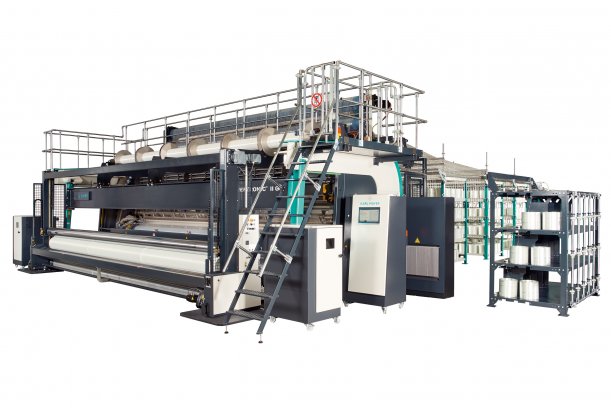Machine premiere and new business potential
Warp Knitting/Crochet
Plaster grid warp knits for the billion euro China market
According to machinery manufacturer Karl Mayer, its Wefttronic II G for glass processing is taking off in China...

22nd April 2020
Knitting Industry
|
Obertshausen
The Wefttronic II G. © Karl Mayer.
Karl Mayer Technische Textilien has developed a new warp knitting machine with weft-insertion. The new model, the Wefttronic II G, is specifically designed to produce light to medium-heavy grid structures.
Stable grid textiles are used as plaster grids and geogrids, as well as carriers for grinding discs, and are produced extremely efficiently on the Wefttronic II G, Karl Mayer says.
“Geogrid fabrication is now 60 % more productive compared to the previous version. In addition, less expensive yarns can be processed into high-quality textiles: the textile glass fibre material can cost up to 30 % less than leno fabric production. The machine handles technical yarns extremely gently. Its performance is also impressive,” the company explains.
The first Wefttronic II G was ordered by the Polish manufacturer HALICO in early 2019, followed by orders from China in December. “During our most recent trip to China just before Christmas, we were able to win over two new customers for our company,” said Jan Stahr, Sales Manager of Karl Mayer Technische Textilien. Both companies, Shandong Qiyad and Zibo Glasstex (Shandong Fiberglass), are major players in the industry. After purchasing one machine each, they hinted that they may invest in further WEFTTRONIC II G models, Karl Mayer adds.
An influential family company
Shandong Qiyad is a company privately owned by the Ma family. Mr Ma Xingwang Senior holds shares in two other companies, led by his son and nephew respectively. The companies use around 750 rapier looms in total for their production and thus offer efficiency potential.
“Depending on product quality, between 13 and 22 rapier looms can be replaced by just one Wefttronic II G,” Karl Mayer adds.
Karl Mayer Technische Textilien offers intensive service support to ensure a seamless changeover to new technology and to a state of the art machine. The strong partnership led to further recommendations. “During our meetings, the Ma family also introduced us to other potential customers,” says Jan Stahr. The native region of Shandong Qiyad, Shanxian (Shandong Province), is well known for its plaster grid production. Around 5000 rapier looms are in operation here. The companies are all part of an association. Jan Stahr is already in the process of scheduling a pilot system with some of these companies.
State-owned company with vertically integrated production
The state-run Zibo Glasstex is better known as Shandong Fiberglass. The company has made a name for itself internationally as a manufacturer of glass fibres, rovings and textiles. It is among the top 5 manufacturers of glass fibres in China. The company’s customers in this sector include manufacturers in Eastern Europe who are already operating machines by Karl Mayer Technische Textilien.
Following the successful introduction of the technology with the first Wefttronic II G, Zibo Glasstex plans to invest in further machines.” According to the company’s own information, it intends to work a market with an annual volume of 2 billion m² of textile glass fibre material and to achieve a significant market share. Zibo Glasstex therefore intends to invest in further machines in the mid-term,” Karl Mayer says.
Flexibility put to the test
In order to gain a better understanding of the possibilities relating to glass grid structure production, the new Wefttronic II G machine will be available for customer trials at Karl Mayer (CHINA) in Changzhou from June 2020.
A wide range of equipment options and patterning possibilities will be available to suit a diverse manufacturing process. The different offers can be tested as part of these processing trials. While working on the machine, customers can get a feel for how the design of the fabric influences its properties and product output, and how this correlation can be used to achieve greater efficiency. If, for example, the square cells of a textile grid are formed with a low warp thread stitch density, the weft threads have a significant freedom of movement within the structure.
“The fabric is relatively unstable but is manufactured with a high output. Glass grid manufacturers looking for greater efficiency can use the Wefttronic II G at Karl Mayer (CHINA) to produce warp knitted fabrics with the same properties as their existing products and thus investigate whether there are any advantages.”
“The performance profiles of the textile products are verified by corresponding laboratory values. Companies with vertically integrated production particularly welcome the opportunity to test the machine out. In addition to textiles, they also produce textile glass fibre materials and can therefore test how their own yarns are processed,” Karl Mayer concludes.
The trials are supervised by Karl Mayer’s trained technical staff. “The Wefttronic II G is based on a technology unfamiliar to many glass grid manufacturers. During these trials, they can also discover how user-friendly the new machine is.”

Business intelligence for the fibre, textiles and apparel industries: technologies, innovations, markets, investments, trade policy, sourcing, strategy...
Find out more













